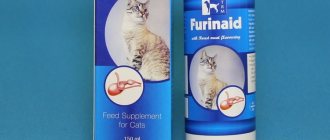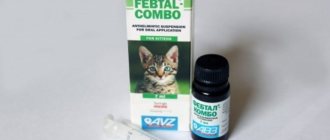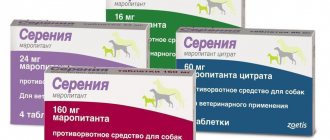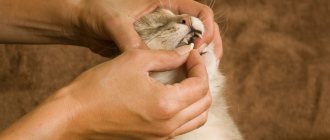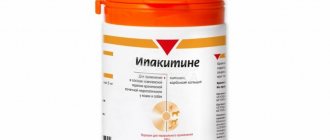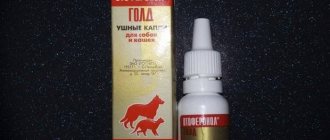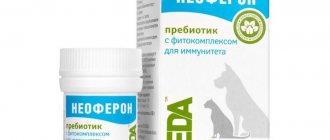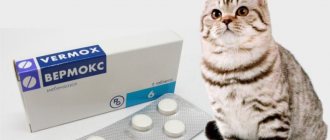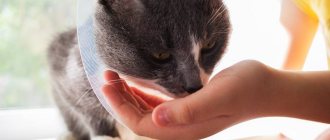Pancreatitis in dogs and cats
| Pancreatitis is inflammation of the pancreas. The pancreas is located in the abdominal cavity next to the stomach and duodenum, and has two main functions - the production of digestive enzymes, which then enter the duodenum, and the production of a number of hormones (including insulin), which enter directly into the blood. | Pavlyuchenko Artem Yuryevich anesthesiologist-resuscitator |
Factors predisposing to the development of pancreatitis are:
- Excess weight and fatty foods, sudden changes in diet in middle-aged and older animals;
- Conditions accompanied by hyperlipidemia, that is, increased levels of fats in the blood (Cushing's syndrome, hyperthyroidism, diabetes mellitus), and the so-called idiopathic hyperlipidemia of miniature schnauzers;
- Increased levels of calcium in the blood (malignant tumors, hyperparathyroidism, vitamin D poisoning);
In addition to miniature schnauzers, breeds that are predisposed to pancreatitis include toy poodles, Yorkshire terriers, Cavalier King Charles spaniels, cocker spaniels, collies, boxers, and Siamese cats.
The direct cause of pancreatitis may be the use of a number of drugs (thiazide and loop diuretics, estrogens, azathioprine, L-asparaginase, sulfonamides, tetracycline, cimetidine and ranitidine, paracetamol, procainamide), poisoning with organophosphorus compounds, pancreatic injuries, shock conditions (significant and prolonged decrease blood pressure), diseases of the small intestine, liver, biliary tract, and in cats - toxoplasmosis and infectious peritonitis.
In many cases, especially in cats, the cause of pancreatitis remains unclear.
Course of the disease
In acute pancreatitis, the symptoms are usually more severe, usually develop suddenly, and changes in the pancreas are usually completely reversible. In chronic pancreatitis, on the contrary, symptoms can develop gradually, but changes in the pancreas are associated with its replacement with scar tissue and are therefore irreversible.
Pancreatitis is accompanied by activation of the pancreas’s own digestive enzymes, “self-digestion,” and the release of highly active enzymes into the blood. This feature of the course of inflammation of this organ determines the severity of the condition of patients suffering from severe forms of pancreatitis. The severe form is characterized by the development of local (formation of cysts and abscesses of the pancreas) and general complications (shock, chemical peritonitis, sepsis).
Symptoms
Owners of animals with pancreatitis often complain that their pet has vomited repeatedly, recently consumed a fatty meal, or changed their diet. The animal exhibits pain when palpating the abdomen, depression, diarrhea, dehydration, and in severe cases shock
Diagnostics
Contrary to popular belief, amylase and lipase activity in the blood are not decisive factors for the diagnosis of pancreatitis. The fact is that, unlike in humans, in acute pancreatitis in dogs and cats the level of these enzymes can be normal, while in other diseases of the gastrointestinal tract, for example, intestinal foreign body or enteritis, their level can be high.
A sensitive test for pancreatitis recently developed at Texas A&M University, called Pancreatic Lipase Immunoreactivity (PLI), is not yet available in Russia.
Considering the above, to diagnose pancreatitis, the doctor must analyze the animal’s symptoms, clinical and biochemical blood test data, and the results of ultrasound and/or abdominal x-ray. Since uncomplicated pancreatitis is treated therapeutically, and its symptoms are similar to those of intestinal obstruction, the main diagnostic task that the doctor solves is to exclude pathology that requires emergency surgical intervention.
Treatment
To date, no drugs have been created that specifically combat inflammation in the pancreas. Drugs such as aprotinin (contrical, trasylol, gordox), sandostatin (octreotide, sandostatin), dopamine in low doses, and a number of others, despite their theoretical benefits for the treatment of pancreatitis, in practice were effective only in the treatment of experimentally induced pancreatitis. In clinical trials on humans and animals with “natural” pancreatitis, these drugs showed ineffectiveness.
Therefore, in the Bely Fang clinics, the drugs listed above, due to their relatively high cost and unproven clinical effectiveness, are not included in the standard therapy of pancreatitis, and can only be used in individual cases.
The main goal of treating pancreatitis is to prevent or combat its complications:
- Infusion therapy (drips) to eliminate dehydration and electrolyte disturbances (various colloid and crystalloid solutions);
- Pain relief (butorphanol, epidural anesthesia);
- Inhibition of gastric acid during vomiting (omeprazole, famotidine and other proton pump blockers and H2-histamine blockers);
- Antiemetic drugs (cerucal, ondansetron, sereniya);
- Prevention of DIC syndrome (heparin) and control of it (plasma);
- Monitoring blood glucose levels;
- Antibiotics - according to indications, in the presence or high risk of bacterial infection.
Nutrition
Currently, both in human and veterinary medicine, there has been a revision of the old principles of treating pancreatitis, briefly formulated as “hunger, cold and rest.” It has been proven that the entry of food into the gastrointestinal tract does not provoke a worsening of pancreatitis, and, on the contrary, earlier initiation of enteral nutrition improves patient survival, reduces hospitalization time and the risk of complications.
It is an axiom that a seriously ill patient, especially a cat, should not fast for more than 1-2 days. Arvid Wretlind, a Swedish physician and chemist, one of the founders of parenteral nutrition, said it best: “The failure of a doctor to provide nutrition to a patient should be regarded as a decision to starve him to death.”
If there is reason to believe that uncontrollable vomiting will last longer than 1-2 days, and natural nutrition through the mouth will be impossible, the issue of installing a tube in the small intestine for enteral nutrition (preferred), or starting parenteral (intravenous) nutrition is considered.
The main guideline when deciding on the transition from tube or parenteral nutrition to natural nutrition is the absence of vomiting, the assimilation of water first, and then liquid food.
Surgery
Sometimes exploratory surgery (laparotomy) is necessary to make an accurate diagnosis. Uncomplicated pancreatitis, however, is treated therapeutically. Indications for surgery include blockage of the bile ducts, pseudocysts and pancreatic abscesses. Abdominal ultrasound is most commonly used to diagnose these conditions.
Consequences of pancreatitis and further treatment
Acute pancreatitis often occurs in a mild form, is completely reversible and does not require further treatment. With the development of chronic pancreatitis, the main components in treatment are diet (especially with elevated levels of lipids in the blood) and enzyme preparations (Creon and analogs), as well as treatment of concomitant gastrointestinal diseases (diseases of the liver and biliary tract, infiltrating enterocolitis).
Significant chronic chronic changes in the pancreas due to its inflammation can lead to insufficiency of its exocrine function or diabetes mellitus, for which specific treatment is used.
Can the drug be administered to pets?
Is it allowed to administer Gordox to dogs and cats? Use in animals is permitted. However, the dosage of the drug should be determined only by a veterinarian and only after an ultrasound examination of the abdominal cavity of the pet.
How to administer Gordox correctly? The use of this medication in cats and dogs should be extremely careful. This is due to the fact that the medication in question is allergenic.
The drug is administered intravenously through a special catheter. It can also be administered subcutaneously, in the area of the so-called “skin.” It should be noted that in the first two days of therapy for pancreatitis it is necessary to carry out intravenous infusions. And only after the pet can eat food without vomiting, the medication can be injected into the withers for another 5-7 days.
What should be the dosage when treating with Gordox? Use in dogs of medium size and weight category (about 15 kg) implies administration of the drug in a volume not exceeding 10 thousand KIU (three times a day). As for cats (weighing about 5 kg), the dosage should be 5 thousand KIE (it is recommended to consult a veterinarian first).
To administer a medicinal substance through a dropper, the contents of the ampoule are drawn into a syringe, and then the skin of the animal is pulled back and the needle is carefully inserted into the subcutaneous space. In this case, the medicine is slowly squeezed out of the syringe.
Description and main properties
Pancreatitis is inflammation of the cells of the pancreas. This organ is responsible for the production of digestive enzymes that enter the intestines and insulin, a hormone that enters the blood.
Typically, the disease develops as a result of an excess of fatty foods in the animal’s diet, which is accompanied by excess weight and accumulation of fat in the blood. The cause of the disease may be concomitant diseases such as diabetes mellitus, hyperthyroidism, existing malignant neoplasms, or the use of certain medications.
Pancreatitis is accompanied by frequent repeated vomiting, loss of appetite or complete refusal of food, pain when palpating the abdomen, weakness, dehydration and stool disturbances.
For pancreatitis, a drug is used that reduces the formation of damage to the pancreas as a result of the formation of enzymes during the next exacerbation - Gordox for cats. The instructions for use must be read before using the drug.
The drug has hemostatic, antiproteolytic and antifibrinolytic properties. It is widely used to reduce bleeding caused by high levels of blood clot-dissolving substances during surgery.
Mechanism of action
Aprotinin weakens the process of inflammation of the pancreas and increases blood clotting, which is very important during surgical operations. It is a polypeptide compound that affects the production of trypsin, plasmin and kallidogenase.
The active substance has antiproteolytic and hemostatic properties, which make it possible to delay the formation of kallikrein in the body.
After application, the drug is very quickly distributed in the intercellular space of tissues, which leads to a decrease in its amount in the blood plasma. The effect of the drug begins 0.4−0.8 hours after intravenous administration. The active substance accumulates in the epithelial cells of the kidneys, cartilage tissue and in the brain.
Metabolism occurs in the kidneys, and the remaining drug is excreted in the urine within 10 hours.
Instructions for use
The drug is intended for intravenous or subcutaneous administration using a catheter or syringe into the interscapular area. For effective treatment, it is recommended to start using Gordox at the initial stage of the disease. In this case, the drug is used for a long time in high doses.
The dosage of the product is selected by a specialist for each animal individually after a diagnostic examination.
Considering that the active substance can cause the development of an allergic reaction, a test dose of 1 ml should be administered. If no adverse reactions occur after the injection, then the therapeutic dose is administered in full. To avoid the development of allergies, the cat can be given an antihistamine 30 minutes before the medication is administered.
The dosage of Gordox for cats, according to the instructions for use, is selected taking into account the weight of the pet. The following amount of the drug is used for treatment:
- up to 5 kg - 0.5 ml;
- 5−10 kg - 1 ml.
For larger animals, the doctor must calculate the dose of the medicine individually.
When treating acute pancreatitis, the drug is administered intravenously for the first two days. After the symptoms are relieved, when attacks of vomiting do not bother the cat, the solution is applied subcutaneously once a day. The duration of therapy is 5−7 days.
The drug should not be used to treat pregnant and lactating animals, since the effect of the active substance on the body has not been sufficiently studied.
Special instructions for the use of the drug
Now you know how to use a medical product such as Gordox. Instructions for use for pancreatitis and other diseases were presented just above. However, before starting treatment with this drug, it is recommended to carry out skin tests that will allow you to determine the individual sensitivity of a person to the active substance of the drug (that is, aprotinin).
If a history of allergic reactions was indicated, then before therapy the patient must take GCS and histamine H1 receptor blockers.
If abnormalities such as hyperfibrinolysis and disseminated intravascular coagulation occur, the drug should be used only after these phenomena have been completely eliminated. The same applies to those cases when the patient has a prophylactic effect of heparin.
The medicine in question is prescribed with extreme caution to those patients who have received muscle relaxants for several days before starting therapy.
The drug "Gordox" contains benzyl alcohol. In this regard, its maximum volume per day should not exceed 90 mg per kg of human weight.
The drug "Gordox" is not a substitute for a medicine such as "Heparin".
After the ampoule with the solution has been opened, it should be used immediately. During repeated use of the drug, it is prohibited to administer the medicine from an open container.
It is highly undesirable to mix Gordox with other medications.
Owner reviews
Some time after eating, the cat began to vomit. At first I associated this with systematic overeating, but the vomiting was irregular. Later the animal began to lose weight. Her appetite has worsened. And after some time she completely refused to eat. The urine has turned orange. The fur became disheveled. The veterinary clinic recommended Gordox injections. They gave injections for three days. The condition was stabilized. The cat began to eat and became active.
Marina
We took an adult cat from the street. It turned out that he had a whole “bouquet” of diseases. The veterinarian diagnosed urolithiasis and liver damage caused by insufficient production of enzymes by the pancreas. Gordox was prescribed intravenously. I'm currently taking injections. The cat began to feel much better. I hope the medicine will help him.
Victoria
An effective remedy that is often prescribed for the treatment of acute and chronic pancreatitis. The drug helps stop bleeding. I consider the large number of side effects to be a disadvantage, so I recommend using Gordox only after consulting a doctor.
Svetlana Alekseevna, veterinarian
Side effects
Gordox is always prescribed with caution, since despite its high effectiveness, this medicine has a large number of adverse reactions. The most important of which is the development of an allergy to the main active ingredient of the drug - aprotinin.
© shutterstock
Animals exposed to Gordox for the first time tend to be less susceptible to side effects, which include the following:
- allergies leading to anaphylactic shock;
- disturbances in the functioning of the cardiovascular system;
- severe arrest of hematopoiesis, up to DIC syndrome (formation of blood clots);
- disorders of the kidneys;
- liver failure.
If any deviations in the animal’s condition occur, you should immediately contact a specialist.
Thus, the use of “Gordox” for cats becomes a real salvation if the animal has received deep wounds and urgently needs to increase blood clotting. This medicine also helps greatly with pancreatitis, especially during acute attacks of the disease. On the other hand, Gordox has a huge number of side effects, and its administration to a cat can only be done by a specialist in a laboratory setting. Therefore, consultation with a veterinarian who will prescribe the correct treatment and make an accurate diagnosis is more important than ever.
Contrical inhibits enzymes by forming protein spatial structures with them, which subsequently disintegrate. The drug can form such complexes with plasmin, kallikrein, kininogenases, trypsin and chymotrypsin and, accordingly, inhibit the activity of these enzymes.
The active ingredient of the drug aprotinin effectively eliminates pathological conditions caused by the increased activity of the listed enzymes - plasmin, kallikrein, kininogenase, trypsin and chymotrypsin. And such pathological conditions include pancreatitis, pancreatic necrosis, bleeding and a number of others.
However, the drug is not able to stop all types of bleeding. Contrical is effective only for stopping bleeding that is caused by an enhanced process of fibrinolysis. Fibrinolysis is a natural physiological process of destruction of a previously formed blood clot that is no longer needed. However, in various pathologies, fibrinolysis processes are enhanced under the influence of enzymes, and as a result, the blood stops clotting. These conditions occur in women giving birth.
It is also possible to enhance fibrinolysis under the influence of drugs that are used specifically to dissolve blood clots in heart attack patients and people suffering from a tendency to increased thrombus formation. In this case, increased fibrinolysis is a complication of thrombus dilution therapy.
Contrikal's activity is high and its spectrum is wide, that is, the drug is able to inhibit many classes of enzymes. Therefore, it can also be used for prophylaxis for any disorders associated with excessive enzyme activity.
Kontrikal for children - application features
Contrical can even be used for
. However, this should be done strictly according to indications, without trying to “overdo it” by giving the child a serious medicine for prevention and self-soothing. The dosage of Contrikal for children whose body weight is less than 50 kg is calculated by weight. In this case, they use the formula: 14,000 ATRE per 1 kg of body weight.
However, today the problem of rational use of Kontrikal is quite acute, especially in maternity hospitals in some regions of the country. The fact is that the drug is often prescribed to children with regurgitation syndrome. Moreover, even if there are no brown streaks in the regurgitated masses (a sign of bleeding), but only bile impurities.
In this case, there is a common functional childhood syndrome called “gastroesophageal reflux without bleeding.” Many children suffer from this functional disorder, which usually goes away on its own by the age of six months. And regurgitation syndrome is caused by weakness of the sphincter, which separates the stomach from the esophagus.
As the child develops and muscle tone appears, this syndrome disappears without a trace. In this case, “hedging” is the unjustified use of a drug to treat a condition that is not an indication for its use. Unfortunately, such unjustified use of drugs in children often leads to toxic hepatitis and cirrhosis of the liver.
Speaking about regurgitation syndrome, it should be said that this condition is quite widespread, especially among children born prematurely. However, the internationally accepted and recommended treatment for this syndrome (according to Nelson's guidelines) is not simple. You will have to do a lot of manipulations that require attention and physical effort, and not be limited to a dropper.
So, to eliminate regurgitation syndrome, the baby should be placed in such a way that his head is about 30o higher than his legs. For feeding, it is necessary to choose relatively thick mixtures. After feedings, use agents that accelerate the movement of the food bolus from the stomach and intestines (for example, Reglan or Cerucal).
It is also advisable to give the child antacids (for example, Almagel, Phosphalugel) or H2-histamine blockers (for example, Zantag or Tagamet). No other medications should be used to treat regurgitation syndrome. However, treatment can last only until the age of 6 months, since after this the child’s muscles become stronger, the sphincter normally retains the contents in the stomach, and the child ceases to suffer from gastroesophageal reflux.
However, a severe course of gastroesophageal reflux is possible in children of the first year of life. In this case, it is necessary to resort to surgery, which is indicated for the development of the following complications of regurgitation syndrome in a child:
- developmental delay;
- recurrent aspiration pneumonia;
- anemia due to bleeding from the esophagus;
- frequent vomiting;
- large hiatal hernia;
- erosions, ulcers or narrowing of the esophagus.
Use during pregnancy and lactation
Studies regarding the effects of the drug on the body of pregnant women have not been conducted. During pregnancy, the use of Gordox is permissible only if the potential benefits of therapy for the mother significantly outweigh the possible risks for the fetus. When assessing the benefit/risk ratio, it is necessary to take into account the negative impact on the fetus of severe adverse reactions that sometimes occur during the administration of a drug, which include cardiac arrest, anaphylactic reactions, etc., as well as treatment procedures that are carried out to eliminate these reactions.
The effect of Gordox on lactation has not been sufficiently studied. The drug is considered potentially safe if it enters the baby's body through breast milk, since the bioavailability of aprotinin when taken orally is minimal.
Studies regarding the effects of the drug on the body of pregnant women have not been conducted.
During pregnancy, the use of Gordox is permissible only if the potential benefits of therapy for the mother significantly outweigh the possible risks to the fetus. When assessing the benefit/risk ratio, it is necessary to take into account the negative impact on the fetus of severe adverse reactions that sometimes occur during the administration of a drug, which include cardiac arrest, anaphylactic reactions, etc., as well as treatment procedures that are carried out to eliminate these reactions.
Analogs and price
“Gordox” costs about 5,000 rubles in pharmacies. (25 ampoules), and the cost of 1 ampoule is approximately 200 rubles.
If it is unavailable, you can consider purchasing analogues with aprotinin:
"Gordox" is an aprotinin-based proteolysis inhibitor and has an antifibrinolytic effect. For cats, it is usually prescribed for acute problems with the pancreas. Prescribed and used exclusively as prescribed by a veterinarian.
Drug interactions
Diarcan is an antibiotic for the treatment of intestinal infections, which is available in the form of sugar cubes. Externally they are light pink in color. There is a groove in the middle, thanks to which it is easy to divide the cube into two parts. Blisters are used for packaging. Each blister contains 8 briquettes.
The effect of the drug is due to three active components. Includes:
- sulfaguanidine;
- benzonaphthol;
- ratania extract.
An auxiliary component is sucrose, which gives the medicine a sweet taste, which makes feeding the briquettes to pets easier.
The drug has a long service life - 5 years from the date of production. To prevent the medicine from losing its pharmacological properties, you need to choose a dry place for storage, inaccessible to direct sunlight. Storage temperature should not exceed 25˚C. Children and pets should not have access to the medicine.
Gordox is compatible with 20% hydroxyethyl starch solution, glucose solution and lactated Ringer's solution.
When Gordox is used simultaneously with urokinase, streptokinase and alteplase, the activity of these drugs is reduced.
Gordox should not be mixed with other medications.
When using Gordox with other drugs, undesirable interactions may occur, which are caused by the mutual influence of active or auxiliary compounds on each other.
Thus, the active ingredient Gordox blocks the effect of thrombolytics and enhances the effect of heparin preparations. When used together with dextran, the effect of both drugs is enhanced, resulting in an increased risk of acute intolerance to these drugs.
Contrical for cats and dogs - instructions for use in animals
Contrical is a drug that is used for the treatment and prevention of various pathological conditions. So, the drug is indicated to stop bleeding in the following conditions:
- after surgical interventions on the prostate and lungs;
- due to amniotic fluid embolism;
- after injuries;
- developing against the background of extracorporeal circulation;
- labor bleeding (before, after and during childbirth).
In these situations, Contrical is used as a hemostatic, that is, a hemostatic agent. In addition, the medicine is indicated for use in the treatment of the following pathological conditions:
- acute pancreatitis;
- pancreatic necrosis;
- chronic pancreatitis with a tendency to relapse;
- increased bleeding associated with increased fibrinolysis;
- acute nonspecific postoperative parotitis (mumps);
- Quincke's edema;
- severe conditions - endotoxin, traumatic, burn and hemorrhagic shock;
- deep tissue damage;
- large area of tissue damage.
- “self-digestion” of the pancreas during operations on it or neighboring organs (prevention of postoperative pancreatitis);
- postoperative embolism;
- postoperative bleeding;
- embolism with fat particles during injuries, especially with fractures of large bones of the leg or skull.
In addition, during coronary artery bypass surgery, which requires artificial circulation, Contrikal is also used to prevent blood loss and reduce the volume of blood transfused.
Contrical is intended exclusively for intravenous administration. This can be done in the form of a dropper or an injection. Often the dosage of the drug is set individually, based on average values. Treatment will be most successful if it begins early in the disease and is carried out in high doses for a relatively long time.
The average initial dosage of Contrikal is 300,000 ATRE, and the maintenance dosage is 30,000 ATRE. The drug should be administered to a person in a lying position. The maximum permissible rate of administration of the initial dose of Contrikal in the form of an injection is from 5 to 10 ml/min. The maintenance dosage of the drug is administered exclusively as a dropper.
Since the drug is of animal origin, it can cause allergies. Therefore, before administering the main dose, it is necessary to administer a sample in the amount of 10,000 ATRE (1 bottle). The test must be carried out in people who have had an allergic reaction to the substance aprotinin in the past (for example, Contrical, Gordox, etc.).
To date, not a single case of overdose with Contrikal has been identified, even in cases of use of the drug in doses significantly higher than recommended.
The general rules for using Contrikal were listed above - now let’s look at the dosages and duration of use for various specific pathological conditions.
Acute pancreatitis
The initial dose of Contrikal is 200,000 - 300,000 ATRE, which must be administered in the form of a dropper. Then they switch to a maintenance dosage, which is 20,000 - 30,000 ATRE and is administered every hour. In this case, the maximum amount of the drug administered in maintenance doses is 200,000 - 300,000 ATRE during the day.
Exacerbation of chronic pancreatitis
Over the course of 3–6 days, a person is administered 25,000–50,000 ATRE Contrical per day.
Prevention of traumatic pancreatitis
Prevention of traumatic pancreatitis requires the administration of 200,000 ATRE before surgery, and after surgery, 100,000 ATRE every 6 hours for 2 days.
Bleeding due to increased fibrinolysis
To stop it, from 300,000 to 1,000,000 ATRE of Contrical is simultaneously introduced. Then the administration of maintenance dosages of 140,000 ATRE is continued every 4 hours. Maintenance therapy is carried out until laboratory parameters of hemostasis normalize. If bleeding during the use of fibrinolytic drugs to lyse blood clots turns out to be massive, then it is advisable to combine Contrikal with synthetic drugs from the group of antifibrinolytics (for example, Aminocaproic acid and Ambien).
If there is prolonged bleeding, which is insignificant in terms of the volume of blood lost (for example, a small cut or scratch, etc.), then it is better to use Contrical topically. To do this, it is necessary to prepare a solution with a dose of the drug of 100,000 ATRE, which is used to soak a gauze bandage. Apply this bandage to the bleeding site for 20 minutes.
Obstetric bleeding (before, after and during childbirth)
If such bleeding develops, the woman is simultaneously administered Contrical at a dose of 1,000,000 ATRE. After this, a dropper is placed, which ensures the supply of the drug at a rate of 200,000 ATRE per hour. Continue the drip until the bleeding stops completely.
If women in labor develop DIC syndrome, Contrical can be administered only after all signs of this pathological condition have been eliminated, and together with heparin.
Prevention of bleeding during surgical interventions
Before the operation, 200,000 ATRE is administered simultaneously as an injection. Then, after it, 100,000 ATRE is administered every 6 hours for two days.
The initial dose of Contrical is 300,000 - 400,000 ATRE, and the maintenance dose is 200,000 ATRE, which is administered every 4 hours.
Contrikal dropper - rules for setting it up
Sodium chloride (saline solution), 20% is used as an infusion solution.
, Ringer or Hartman. The required number of bottles with Contrikal are diluted with saline solution from the ampoules that are included in the kit. Then the contents of these ampoules are poured into an infusion solution (dropper). Usually 100–200 ml of infusion solution is taken, depending on the dose of Contrikal. Then, observing the rules of asepsis, the needle is inserted into the vein, and the drip speed is set at 5 ml/min.
Contrikal injections - rules for setting
To administer Contrikal as an intravenous injection, the required amount of lyophilisate should be diluted with physiological solution from the ampoules that are included in the kit. This means that 2 ml of physiological solution is added to each bottle with lyophilisate. It should be remembered that one bottle contains Contrical in a dose of 10,000 ATRE. That is, if it is necessary to administer 30,000 ATRE, then three bottles with lyophilisate will have to be diluted.
Having diluted the required number of bottles to obtain the required dosage, you should calculate how much of the solution is obtained in general. For example, at a dose of 30,000 ATRE, the contents of three bottles are diluted, each containing 2 ml - therefore, in total, you get 6 ml.
After this, you need to take a syringe of a suitable volume and put the entire amount of Contrikal into it.
Attach an intravenous needle to the syringe.
Then insert the needle into the vein and begin slowly injecting the drug, at a rate of no more than 5 ml/min.
Contrical should be used with caution in cats and dogs, since the drug is allergenic. The medicine is administered intravenously through a catheter, or subcutaneously in the scruff area. However, in the first two days of treatment for pancreatitis, Contrikal will have to be administered through a catheter, and after the animal is able to eat without vomiting, you can continue to use the drug in the scruff of the neck for another 5 to 7 days. The drug must be administered very slowly.
For a medium-sized dog (15 kg), the dosage is 10,000 ATRE (1 ampoule) three times a day. For an average cat (5 kg), the dosage of Contrikal is 5000 ATRE (half an ampoule), also three times a day. For administration through a dropper (catheter), the contents of one bottle are diluted in the solution that is included in the kit, and we obtain the finished drug in a volume of 2 ml.
These 2 ml are poured into 10 ml of saline, which is administered drip through a catheter. After switching to subcutaneous administration of Contrikal, only 2 ml of the solution is taken, obtained by diluting the powder with the solvent from the kit. This solution is drawn into a syringe, the skin of the animal is pulled back, the needle is carefully inserted into the subcutaneous space, and the medicine is slowly squeezed out of the syringe.
The instructions for use indicate that Diarcan is prescribed to cats for the treatment of enteritis caused by E. coli, salmonella or other bacteria sensitive to the active components of the drug. Sometimes the drug is used for diarrhea of unknown origin, but only after consulting a doctor.
A single dose of the drug is equal to ½ cube, regardless of age. For large animals that weigh more than 5 kg, sometimes the single dose is increased to one cube. The medicine can be given in its pure form, but it is better for cats to mix it with a small amount of food. You can also dissolve the cubes in water, and then feed the animal with the solution.
The drug is given twice a day. There should be a time interval of 12 hours between doses of the drug. In case of severe disorder, medication intake may be increased up to 3 times. In this case, the drug should be given every 8 hours. The duration of treatment is determined by the doctor in each case individually, taking into account the symptoms and characteristics of the course of the disease, but is usually 3-5 days. If after 2 days of taking the medication, the pet’s condition does not improve, an antibiotic from a different drug group is selected.
Note! Diarcan promotes the formation of salt crystals, which can cause urolithiasis. To prevent this, the animal must have free access to water during the treatment period.
Gordox for pancreatitis: instructions and alternatives
Pancreatitis is a dangerous disease of the pancreas. The disease occurs when tissue becomes inflamed due to the destruction of an organ by accumulated proteases. As a result, necrosis of the mucous membrane begins, which can become acute or chronic. Pancreatitis poses a serious threat to human life, so previously patients were required to undergo surgery. Today, conservative treatment methods based on the use of antienzymes are used. Gordox belongs to this group of medications.
Compound
Gordox belongs to the category of hemostatic drugs. It is made from aprotinin, which is a polypeptide with sixty types of amino acids. This fibrinolysis inhibitor is obtained from animal raw materials, more precisely, from the salivary glands of cattle. The content of the active ingredient in 1 ml of the drug is equal to 10,000 kallikrein inhibitory units or KIE.
Benzyl alcohol and sodium chloride are included as additional compounds in the multivalent plasma proteinase inhibitor. Gordox is available in the form of a concentrate, diluted in a special solution for infusion of liquid intravenously.
Return to contents
Clinical pharmacology
Hordox is dynamically capable of suppressing the active activity of enzymes and proteases that destroy protein. Thanks to its powerful inhibitory properties, the proteolytic prevents and stops bleeding, initiates the processes of converting plasminogen into plasmin, which improves the effectiveness of the fight against pancreatitis. Pharmacology of Gordox expands the scope of application of the drug. Therefore, it is prescribed not only for the treatment of pancreatitis.
The kinetics of the drug’s action on the body is characterized by the uniform distribution of the active substance in tissues and organs. After complete loss of activity in the gastrointestinal tract, aprotinin is excreted from the body in the form of metabolites. Hordox tends to accumulate in the kidneys and cartilage tissue. In this case, the medicine does not penetrate the brain, cerebrospinal fluid, and is not absorbed into the placenta.
Return to contents
Indications and contraindications
Necrosis is an indication for the use of this medicine.
The use of Gordox in medicine is indicated when:
- acute and aggravated chronic forms of pancreatitis;
- pancreatic necrosis with severe and frequent relapses;
- pancreatitis acquired after injuries and operations.
In addition, the drug is prescribed to relieve, reduce the intensity of bleeding, improve blood supply to organs, and eliminate post-traumatic, post-burn and post-toxic shock.
The main contraindications include:
- allergic reactions to aprotonin and other components of the drug;
- lactation;
- period 1 and 3 trimesters of pregnancy.
Otherwise, Gordox is prescribed when taking the medicine is characterized by less risk than the expected benefit.
Return to contents
Factory release form
The manufacturer of the drug for pancreatitis is the Hungarian company Gedeon Richter. The drug is supplied in the form of a concentrate diluted in saline solution. The fluid is then used for intravenous infusion.
Packaging is carried out in ampoules of 10 ml of concentrated substance containing 100,000 KIU of aprotinin.
Return to contents
Doses used
One of the forms of release of the drug.
The instructions for use regulate precise doses of Gordox, according to each individual case. Single doses are selected depending on the nature and severity of pancreatitis. Always before prescribing a medicine, a test is carried out to determine the body’s ability to form antibodies to the main substance.
For acute pancreatitis diagnosed in adult patients, Gordox is prescribed at an initial dose of 50,000 with a gradual increase to 1,000,000 KIU. The medicine is used for 2-6 days. In case of relapse of chronic pancreatitis, a dose of 25,000 to 50,000 KIU is prescribed with a duration of 6 days for single use per day.
In the postoperative period, that is, after surgery on the pancreas, Gordox is prescribed in a dose of 200,000 KIU for the first dose. Subsequently, this number decreases to 100,000 KIU. The frequency of administration per day is 4 times for two days. Pediatric dosage for pancreatitis is calculated depending on body weight: 20,000 KIU is required for 1 kg of child weight. It is recommended to start intravenous infusion with the appearance of the first symptoms of exacerbation of the disease.
The only rule for using the drug is that the medicinal solution is administered intravenously in a horizontal position of the patient at a rate of 5-10 ml per minute.
Return to contents
Side effects
Common complications after intravenous infusion of Gordox:
- Fluctuations in blood pressure, increased heart rate, which increases the risk of myocardial infarction. To avoid complications, it is recommended to strictly adhere to the main rule of drug infusion.
- Pain in muscle tissue, myalgia.
- Nausea, diarrhea, which occur with an increased rate of solution administration.
- Allergic reactions due to increased sensitivity to aprotinin manifest themselves as bronchospasms, itching, swelling, and anaphylactic shock. After repeated infusions, the allergy decreases sharply.
- The incidence of side effects from the drug is 2/3 of all cases.
If an acute form of allergy occurs, according to the instructions, it is recommended to suspend the course of treatment with Gordox and replace it with symptomatic therapy.
Return to contents
Possible alternative to Gordoks
Analogues made with aprotinin as an active ingredient are Aerus, Trasylol 5,000,000, Ingiprol, Vero-Narcap, Kontrikal, Ingitril, Aprotex.
Return to contents
Reviews of Gordox
General practitioners recommend the drug as an effective treatment for pancreatitis. The drug treats inflammation of the pancreas in chronic and acute forms. The medicine easily stops bleeding of any nature. A negative factor in reviews of the drug is the presence of a large number of side effects, which in some severe cases can be fatal.
Therefore, the drug is prescribed only for serious indications and as prescribed by the attending physician. While undergoing treatment with Gordox, the patient must be under the strict supervision of a specialist.
pishchevarenie.ru
Contraindications
Sensitivity or allergy to aprotinin, mannitol or bovine protein.
Disseminated intravascular coagulation syndrome (DIC).
First trimester
(up to 12 weeks of gestation).
Period
The presence of allergic diathesis or a tendency to hypersensitivity reactions are relative contraindications to the use of Contrikal. That is, the drug can be used, but with caution and under close medical supervision.
An antibacterial agent helps relieve an animal of pain, diarrhea and other symptoms of infection with E. coli or other bacteria, but it cannot always be used. Diarkan has a number of contraindications:
- urolithiasis disease;
- hypersensitivity to the components of the drug;
- kidney diseases;
- liver dysfunction;
- pregnancy.
You cannot use an antibiotic for kittens if their weight does not reach 1 kg, or during the suckling period.
Note! If your animal has diabetes, you should consult a doctor, as the cubes contain a large amount of sucrose.
The use of Diarkan should not be combined with ascorbic acid and other drugs that can increase the acidity of urine. In this case, the risk of salt formation in urine increases. Also, you cannot use an antibiotic and the following drugs at the same time for treatment:
- definin;
- non-steroidal anti-inflammatory drugs;
- sulfonylurea derivatives;
- coumarin anticoagulants (blood thinning medications).
An antibacterial agent enhances the effect of the above listed drugs, which increases the risk of adverse reactions.
- Age under 18 years (the safety and effectiveness of the drug for this age group have not been established);
- Hypersensitivity to the components of the drug.
Its peculiarity is the ability to suppress the activity of certain proteolytic enzymes (plasmin, trypsin, kallidinogenase, etc.
) In this case, both the total proteolytic activity and individual enzymes of this series are inhibited.
Aprotinin modulates the systemic inflammatory response that occurs during operations under artificial circulation and leads to the interconnected activation of hemostasis, fibrinolysis, and activation of the cellular and humoral response.
The drug Gordox is also effective in treating lesions of the pancreas, shock conditions of various origins, and reduces the fibrinolytic activity of the blood.
Composition and release form
Aprotinin is an active component of an anti-inflammatory and anti-enzyme agent. 1 ml of medicinal solution for intravenous administration contains 10,000 KIU of the main substance.
Aprotinin is a substance of natural origin. The natural product is extracted from the organs of cattle, subjected to disinfection and specific processing. The protein molecule of aprotinin consists of several types of amino acids.
The high activity of the polypeptide is manifested against the background of maintaining part of the substance unchanged. The greatest accumulation of the active component was observed in the kidneys and cartilage tissue; doctors recorded the minimum concentration of aprotinin in the cerebrospinal fluid. The half-life is from 20 minutes to 10 hours. The speed of the process depends on the breakdown of the main substance into short protein chains and polypeptides, and the excretory ability of natural filters.
The injection composition is contained in glass ampoules; the volume of aprotinin-based liquid in each container is 10 ml. The drug Gordox is dispensed from pharmacies for use in hospitals.
Learn about the symptoms of papillary thyroid cancer and treatment for the disease.
Read about the role of the hormone renin in the body, the normal indicators and the causes of deviations at this address.
Instructions for use of the drug
The medication is injected into a vein or under the skin of a lying animal. This is done slowly, maintaining sterility.
Usually "Gordox" is used for acute pancreatitis in cats. The dosage is determined by the veterinarian based on the weight of the animal. Individuals weighing up to 5 kg are prescribed a daily dose of 0.5 ml. For cats and kittens weighing from 5 to 10 kg, use 1 ml of medication.
In case of an acute condition, during the first 2 days an injection into a vein is given once a day. The next 3–5 days, when the symptoms of pancreatitis (vomiting, pain) are relieved, a daily subcutaneous injection is given.
Important! Since there are risks of allergies, before treatment with Gordox, make a test of 1 mg of the drug or give the cat an antihistamine half an hour before the procedure. >Overdose
To date, there have been no cases of overdose with this medication. No antidote to Gordoks has been created.
"Gordox" cannot be mixed with other medications, as it does not combine with them. It can be used with 20% glucose solution and some other electrolyte solutions.
The effect is enhanced when aprotinin and dextran are used together, but the likelihood of allergies increases.
Gordox for dogs
Indications and contraindications for use
The drug may be prescribed for the following cases:
- for bleeding (due to injury, surgery, childbirth);
- exacerbation of pancreatitis or its acute forms;
- shock of various etiologies;
- significant and numerous injuries, fractures.
Most often, the reason for taking the medicine is acute conditions of pancreatitis. The animal tolerates them with difficulty - vomiting is observed, including on an empty stomach, lethargy, dehydration, bowel problems (diarrhea or constipation). "Gordox" helps relieve these symptoms. The cat is prescribed the necessary examination (ultrasound, blood test) and the cause of the disease is looked for. Treatment is usually prescribed comprehensively with obligatory adherence to a diet.
Contraindications to the use of Gordox are allergies to its components, pregnancy and lactation of the cat.
Did you know? Almost 90% of cats that fall from great heights survive. Moreover, the probability of a successful landing when falling from the roof of a 10-story building is higher than when falling from the 5th floor.
